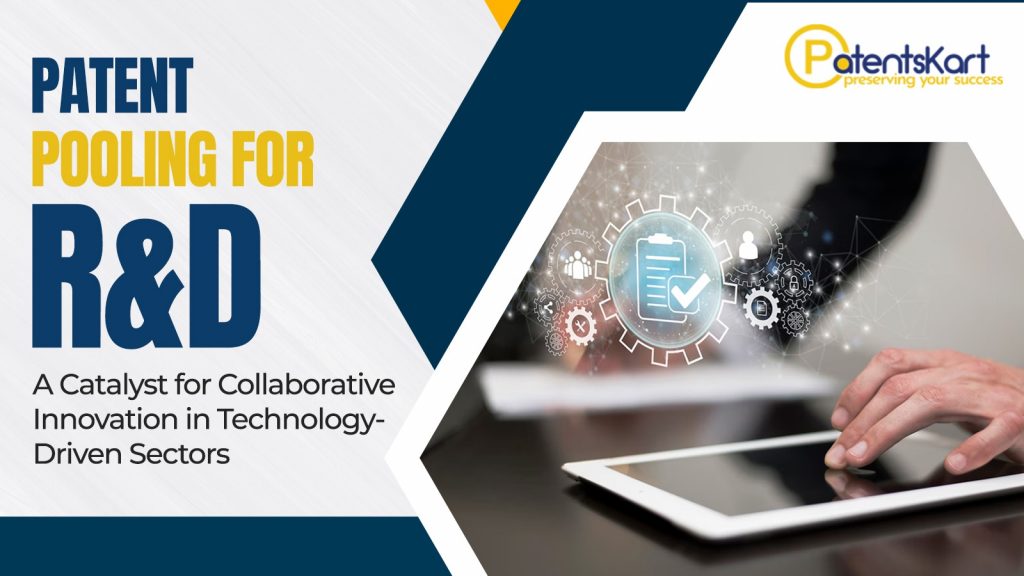In technology-driven sectors, innovation is driven by the rapid pace of research and development (R&D) and the need to stay ahead of the competition. However, this constant push for innovation often brings challenges such as high R&D costs, complex intellectual property landscapes, and potential patent litigation. To overcome these barriers, companies are increasingly turning to patent pooling as a strategic approach to foster collaboration and streamline the development of new technologies. By sharing their patents within a collective, companies can reduce costs, minimize litigation risks, and accelerate innovation.
This blog explores how patent pooling is becoming a catalyst for collaborative innovation in technology-driven sectors, providing practical insights, highlighting emerging trends, and offering actionable steps for companies looking to leverage this strategy effectively.
The Role of Patent Pools in Technology-Driven R&D
Patent pooling, at its core, involves multiple patent holders coming together to pool their patents and license them as a single package. This collaborative approach is particularly advantageous in sectors like telecommunications, semiconductors, biotechnology, and software, where products and technologies often require the integration of numerous patents. Here’s how patent pools can drive R&D and innovation in these fields:
1. Facilitating Access to Essential Technologies
In industries characterized by rapid technological advancements, patent pools provide a streamlined pathway for accessing essential patents. For example, in the development of 5G technology, numerous companies hold patents essential to the standard. A patent pool allows these companies to bundle their patents together and license them out as a package, making it easier for others to develop compatible products and services without navigating a web of individual licenses. This not only speeds up the development process but also encourages widespread adoption of new technologies.
2. Reducing Patent Thickets and Litigation Risks
Technology-driven sectors often suffer from “patent thickets,” where overlapping patent rights held by different entities create a dense web that can hinder innovation. Patent pools help mitigate these issues by consolidating patents into a single licensing entity, reducing the complexity of the IP landscape. This consolidation minimizes the risk of costly litigation over patent infringements, allowing companies to focus their resources on innovation rather than legal battles.
3. Promoting Collaborative R&D Efforts
By bringing together various patent holders, patent pools foster a collaborative environment where participants can share their expertise, resources, and IP assets. This collaboration can lead to joint R&D projects, shared risk, and accelerated technological development. For instance, the biotechnology sector often benefits from patent pools where companies collaborate to develop new therapies and diagnostic tools, leveraging each other’s patented technologies to achieve breakthroughs faster than they could independently.
Emerging Trends in Patent Pooling
As patent pooling continues to evolve, several emerging trends are shaping its future in technology-driven sectors:
1. Increased Use of Standard-Essential Patents (SEPs) in Pools
There is a growing trend of incorporating standard-essential patents (SEPs) into patent pools. SEPs are patents essential to a particular industry standard, and their inclusion in pools facilitates the adoption of these standards by providing a single point of access to all necessary IP rights. This trend is particularly evident in sectors like telecommunications and consumer electronics, where interoperability is crucial.
2. Expanding Beyond Traditional Sectors
While patent pools have been historically associated with sectors like telecommunications and semiconductors, they are now expanding into new areas such as artificial intelligence (AI), blockchain, and green technologies. This expansion reflects the growing recognition of the benefits of pooling patents in emerging technologies, where the collaborative development of standards and interoperability can accelerate innovation.
3. Leveraging Digital Platforms for Pool Management
With advancements in digital technologies, patent pools are increasingly leveraging online platforms to manage their operations. These platforms streamline the licensing process, provide real-time updates on the status of pooled patents, and facilitate transparent communication among participants. The use of digital tools is making patent pools more accessible and efficient, particularly for smaller companies that may lack the resources to engage in traditional licensing negotiations.
Actionable Steps for Leveraging Patent Pools in Technology-Driven R&D
For companies looking to leverage patent pooling as a strategy for collaborative innovation, here are some actionable steps:
- Identify Key Technologies and Potential Partners: Start by identifying the key technologies in your industry that could benefit from a patent pool. Engage with potential partners who hold complementary patents and share a mutual interest in accelerating R&D efforts.
- Conduct a Thorough Patent Landscape Analysis: Before forming a patent pool, conduct a comprehensive analysis of the existing patent landscape to understand the scope and relevance of the patents involved. This analysis helps identify essential patents and assess the potential impact of pooling them together.
- Establish Clear Governance and Licensing Terms: Successful patent pools require clear governance structures and fair licensing terms. Ensure that the pool operates transparently, with well-defined rules for decision-making, revenue sharing, and conflict resolution. Licensing terms should be fair, reasonable, and non-discriminatory (FRAND) to comply with antitrust laws and promote widespread adoption.
- Engage with Regulatory Bodies Early: Given the potential antitrust implications of patent pools, it is crucial to engage with regulatory authorities early in the process. Ensure that the pool is structured in a way that complies with antitrust laws and avoids any anti-competitive behavior. This proactive approach can prevent regulatory challenges down the line.
- Leverage Technology for Efficient Pool Management: Utilize digital platforms and tools to manage the patent pool efficiently. These platforms can facilitate the licensing process, track IP assets, and provide valuable insights into the pool’s performance. Digital tools can also help in maintaining transparency and fostering trust among participants.
- Continuously Monitor and Adapt: The landscape of technology-driven sectors is constantly evolving, and so should your patent pooling strategy. Continuously monitor market trends, technological advancements, and regulatory changes to ensure that your pool remains relevant and effective. Be prepared to adapt your strategy as needed to respond to new opportunities and challenges.
Conclusion
Patent pooling represents a powerful strategy for fostering collaborative innovation in technology-driven sectors. By providing a structured framework for sharing patents and licensing them collectively, patent pools reduce barriers to innovation, minimize litigation risks, and accelerate the development of new technologies. However, to fully leverage the benefits of patent pooling, companies must navigate the complexities of IP management, comply with regulatory requirements, and embrace emerging trends and digital tools. By doing so, they can position themselves at the forefront of innovation and drive growth in an increasingly competitive market.
Also Read:The Role of SEPs in Fostering Global Technology Interoperability: A Case Study of 5G Cellular Networks ( https://patentskart.com/role-of-sep-in-fostering-global-technology/)







